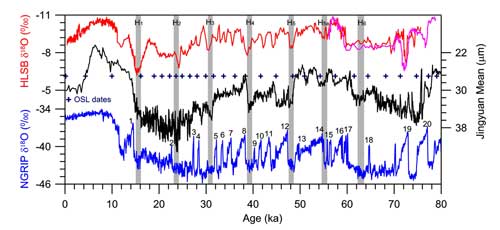Rapid East Asian Monsoon oscillations recorded by Chinese loess are thought to be dynamically linked to north Atlantic climate. However, few efforts have been made to assess the effects of post-depositional processes (e.g., surface mixing and pedogenesis) on loess paleoclimatic records.
Dr. Sun Youbin and his team from Institute of Earth Environment,CAS recently presented a detailed optically stimulated luminescence dating of a thick loess sequence from the western Loess Plateau that offers a reliable chronology for last glacial deposits. They use magnetic susceptibility and mean grain size records from three loess–paleosol sequences along a northwest–southeast transect to evaluate impacts of post-depositional processes on these loess-based proxy records.
Their results indicate that: (1) loess sequences developed within the flat tableland of the central and western Loess Plateau are nearly continuous during the last glaciation; and (2) post-depositional processes have distinct impacts on rapid monsoon signals recorded in loess sequences from different regions. In the central Loess Plateau, rapid monsoon signals have been attenuated to various degrees depending on the sedimentation rate and pedogenic intensity. In the northwestern Loess Plateau, however, due to high sedimentation rate and relatively weak pedogenesis, high-resolution grain size oscillations reliably record rapid monsoon changes and can be well correlated to rapid climate changes recorded in the Greenland ice core and Hulu cave stalagmite.
These results are recently published on Earth and Planetary Science Letters(Sun Y.B., Wang X.L., Liu Q.S., and Clemens S.C. Impacts of post-depositional processes on rapid monsoon signals recorded by the last glacial loess deposits of northern China, Earth and Planetary Science Letters, 29, 171-179, 2010)。

Comparison of Jingyuan MGS oscillations with the δ18O records from Hulu cave stalagmites (Wang et al., 2001) and the NGRIP ice core (NGRIP members et al., 2004) for the interval 25 65 ka. (Credit to Sun et al.,)
65 ka. (Credit to Sun et al.,)
 © 2015 Institute of Earth Environment,CAS
© 2015 Institute of Earth Environment,CAS Address:No. 97 Yanxiang Road, Xi'an 710061, Shaanxi, China

 Location :
Location :